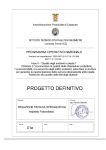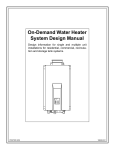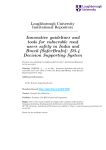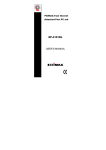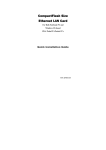Download What`s wrong with technical documentation
Transcript
What’s Wrong with Technical Documentation _ Introduction Technical documentation is supposed to make technology accessible to the average person. A good technical writer must translate difficult and sometimes arcane words into something a person can understand and, more importantly, use to operate a piece of machinery or software. Everyone agrees technical documentation is necessary and important, and when it is good, people are generally happy. The problem is, it is rarely good. Either it is too simplistic to be of much use or too technical to understand. Why is this? Let’s examine some of the root causes. Documentation must be an all-inclusive answer destination Research shows that 40 percent of complaints on technical help lines come from customers having inadequate information, that is, they cannot even find the topic they are trying to reference. Sometimes, the problem is very simple: users cannot find the topic related to the problem they’re having. The Table of Contents and Index, the obvious first places to look, are unhelpful. The topic isn’t listed in either location. A search through a pdf file reveals nothing of substance or hundreds of citations – equally useless for the person wanting a quick answer. So the users, already frustrated because they cannot figure out what they’re supposed to do, get angry that the “help file” is no help at all or the User’s Manual is certainly not for the average user. Overly Technical Documentation Then there is the complaint that the material is too technical. While overly “technical” documentation may sound like a contradiction, in truth, this is a very common problem. When the level of the material is above the user’s understanding of the product or technology, the material is useless. That’s not to suggest that for certain audiences the writing can be overly technical— documentation for software developers, for example, has to be technical. It just means that the writer has to understand the intended audience and write to that level. This problem most often occurs when developers of a product write the documentation. It is difficult for the person who designed and built a product to understand what type of problems a novice user might experience. For a person with intimate knowledge of a product or system to provide useful, clear and concise information © Shoap Technical Services 2 What’s Wrong with Technical Documentation _ to someone less familiar with the product is, if not impossible, very difficult indeed. A real-life example: While trying to print copies of a presentation the other day, a colleague got an error message with a code to reference in the manual to solve the problem. When he looked up the reference code on the screen, the explanation read “You have exceeded the duty cycle capacity of [the machine].” The manual did not, however, explain what a duty cycle was or how to fix the printer when it was over capacity. Upon calling the manufacturer, he discovered that a duty cycle is how long a printer can operate before needing a rest. Psychologists warn against technical jargon Psychologists are advocating banning the use of technical jargon by doctors when trying to diagnose problems with their patients, because they have noticed that using technical jargon above the level of the patient’s comprehension breaks down communication. The patient can no longer answer questions, gets frustrated and interactions double in length and stress. If jargon is confusing in the doctor’s office, imagine how much more confusing it can be in other situations of stress! Since the printer had been left on for the entire time he was trying to resolve the problem, the printer did not have enough time to rest and copies could not be made in time for the presentation. This problem could have been easily solved if the guide had defined a duty cycle and told the user to simply shut off the printer for a while to reset. Instead, the documentation used jargon unfamiliar to the average reader, making it too technical to be helpful. In this case, the writer made a faulty assumption that a person using the printer should understand printer jargon instinctively. To the average user, though, this may not be readily apparent. This makes the manual too technical for most. These technical assumptions in the manual can be frustrating, and they often cause an increase in annoyed customers. Another instance of this can be found in instructions for installing a graphics card into a computer. For this particular model, only four lines of help are given to the new user. The first line simply says to turn the computer off and open the case. The user is then handed this confusing set of lines: 2. Make sure AGP slot in M / B and plug in card properly. 3. Check the connector’s type in VGA and properly connect to your monitor. The final line offers no clarification, but rather reminds the user to close the computer case and turn the monitor back on before using. Since there is no accompanying diagram or picture instruction that makes © Shoap Technical Services 3 What’s Wrong with Technical Documentation _ the process easier, the user is left with a myriad of questions: What is an AGP slot and how do you make sure it is in M/B? What is M/B even? How do you “properly connect” all of the many parts as instructed? After some further exploration, users may be able to figure out how to install the card on their own or they may call the manufacturer. While this accomplishes the same goal, the time and effort expended are much greater than if the instructions were written in an easily comprehensible way. In either case, though, the customer ends up frustrated and the directions are of no use to anyone. In many instances, a technical person will use flow charts, diagrams, and jargon in an attempt to explain a product, even though most users do not find such pedagogical methods very helpful. What technical people often don’t realize is that the use of unfamiliar jargon or of assumptions about product knowledge often comes off as patronizing. This angers the user, and does more harm than help solving the problem at hand. This increases calls to the help line, and often makes the callers disgruntled before the call even begins. Overly Simple Documentation On the flip side, some technical writing is too simplistic to help the reader. In this case, the documentation is easy to follow, but what is written doesn’t actually address the technical nature of the product. After reading this type of material, the readers are no more informed on the intricacies of the new technology than they were before. Rather than simplifying the technology to a level that explains how it works in simple language, the oversimplified documentation just leaves out the more complicated concepts or writes about them in a way that simply is not relevant. Users who want to fully exploit the features of a new product will not be equipped to do so. They will be hindered by the poor technical resource. Most of the time, documentation is unintentionally and unknowingly simplified. This is usually the result of a well-intentioned writer who doesn’t have a clue what the technology is or how it works. Such writers have the © Shoap Technical Services 4 What’s Wrong with Technical Documentation _ mindset of “just tell me the basics and I’ll write it; I don’t need to understand how it works.” In doing so, they go against a basic tenet of any good writing—if you don’t understand what you’re writing about, no one else will either. The overly simplified information often leaves the reader lacking basic information. For example, one online stock management software’s help guide has a list of all of the drawing tools and how to get to them using shortcuts. However, when you click on any of the functions to see what they do, it defines them as “a drawing tool to create charts that can be reached by [whatever] shortcut.” The person looking to the help guide to figure out what the Fibonacci Retracement tool actually does will know as little after consulting the help file as they did before. While there is nothing inherently wrong with the explanation, it is too simple to be useful. This type of documentation is the result of oversimplifying the concepts. Clearly, a writer cannot inform the audience what something is unless the writer knows herself. Whether or not this writer could indeed explain a Fibonacci Retracement, the help guide implies not. Patronizing environments lower performance Psychologists have found that when people feel that they are being patronized, they not only become angry, but that they perform worse on otherwise manageable tasks. The omission of important details of a product annoys the reader, and this anger is only amplified when explanations are so simple that they come off as patronizing. A person who reads the help manual already feels confused and slightly vulnerable. Repetitive or uselessly simple instructions come off as patronizing or just plain stupid. Let’s look at another example. The other day, I was looking at documentation of a popular desktop device synchronization tool. A box labeled Communication Port Selection had appeared, asking me to specify a communications port. The only explanation in the documentation about what to do was to “specify a communications port and click next.” These instructions are simple enough to follow. It doesn’t answer the main question I was asking, though. It is pretty easy to assume that you choose a port and click next to finish the process; however, it is not intuitive what each of the choices are and which you want to use © Shoap Technical Services 5 What’s Wrong with Technical Documentation _ in order to make the device work. Leaving out details about what a communications port is and how it is used makes the process impossible to complete. The documentation is too simple to be helpful. The absence of important components of a product or the oversimplification of directions and definitions make for poor technical writing. The reader comes away from reading the manual no more informed and much more annoyed. The result is an unsatisfied and angry customer. A Simple Solution Often these problems with technical writing could be avoided had the technical writer chosen for the project been both technical enough to understand the material and “naïve” enough about the technology to make sure the material addresses the needs of the audience. Technical writing is not written to be eloquent or pithy, but rather to be concise, easy-to-understand and straightforward. The purpose of any piece of technical documentation is to inform the audience about the intricacies of a product or process without leaving out anything important, such that the average user can easily understand what he is reading. Full-time writers on staff or outsource needs? For a more detailed analysis of the advantages and disadvantages of outsourcing or keeping documentation in house, there is a section in our last whitepaper “Why You Can’t Afford Not to Do Technical Documentation!” © Shoap Technical Services In order to achieve this result, technical writers must be both technical enough to fully understand what they are working with and yet removed enough from the development of the product to be able to describe the learning curve they experienced. This can be achieved by hiring a full-time technical writing staff, or if your needs are less overwhelming than is required of full-time salaried staff, hiring a technical writing consultancy firm. Technical writing doesn’t have to be bad; it just has to be written by qualified individuals. With the right writer, companies can avoid gaps in documentation, overly technical jargon, and overly simplified prose and have happier customers. While it means companies need to find writers with appropriate skill sets, good technical documentation is not only possible, but easily accomplished. 6 What’s Wrong with Technical Documentation _ About Shoap Technical Services: At Shoap Technical Services, we work with you to quickly become a member of your team. Our expertise in documentation and training preparation allows us to provide professional leadership for the team. We are experts in creating documentation and customizing them to your needs. We can demonstrate all of the documentation and training options available and then discuss the timeframes, budget, and requirements of the chosen project. Our mission is to provide you with value-added service on each and every project. Our writers are extremely technical, with degrees and backgrounds in computer science and engineering, and our editors have advanced degrees in composition and communication. We understand software and business processes, and can translate technical concepts into easy-to-follow material for a variety of audiences. We are flexible, so we can take on all of the documentation and training responsibilities for a company, or work with an in-house technical writing group to provide the support you need. We are just as comfortable carrying a process through from start to finish as we are helping our clients start a project and then transitioning it back or finishing a project already in process. We are here to support what you need. For more information, you can contact us at [email protected] or visit our website www.shoap.com. © Shoap Technical Services 7 What’s Wrong with Technical Documentation _ References: Curtis, Anthony J. Health Psychology. New York: Taylor and Francis, Inc. February 2000. “Serving the American People: Best Practices in Resolving Customer Complaints.” National Performance Review. <http://govinfo.library.unt.edu> Shaw, Charla L Markham. “Customer Satisfacftion: Communication Training and the Help-Desk Hot-Line.” <http://www.eric.ed.gov> Vescio, Thresa K. “Power and the Creation of Patronizing Enviornments.” Journal of Personality and Social Psychology. Vol 88. April 2005. <http://www.usernomics.com/documentation.html> (Various manuals on file.) © Shoap Technical Services 8












